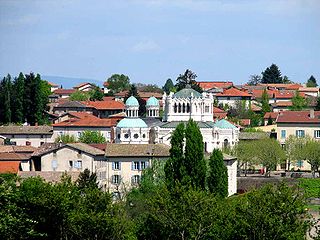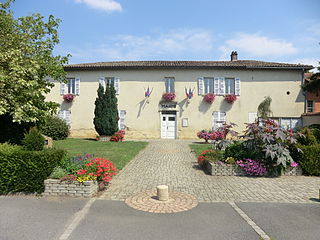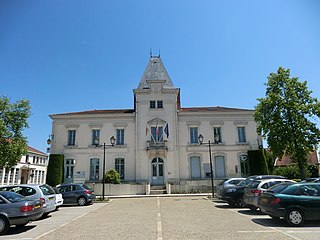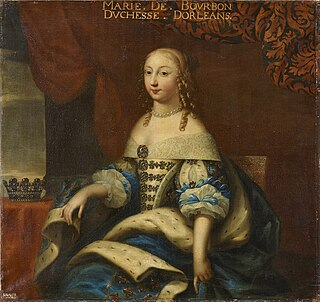
Rhône is a French department located in the east-central administrative region of Auvergne-Rhône-Alpes. Named after the river Rhône, its prefecture is Lyon. Its sole subprefecture is Villefranche-sur-Saône. Including the Lyon Metropolis, it had a population of 1,875,747 in 2019.

Ain is a French department in the Auvergne-Rhône-Alpes region, Eastern France. Named after the Ain river, it is bordered by the Saône and Rhône rivers. Ain is located on the country's eastern edge, on the Swiss border, where it neighbours the cantons of Geneva and Vaud. In 2019, it had a population of 652,432.

Bourg-en-Bresse is the prefecture of the Ain department in the Auvergne-Rhône-Alpes region in Eastern France. Located 70 km (43 mi) northeast of Lyon, it is the capital of the ancient province of Bresse. In 2018, the commune had a population of 41,248.
The Franc-Lyonnais was a province of France.

Ambérieux-en-Dombes is a commune in the department of Ain in the Auvergne-Rhône-Alpes region of eastern France.

Ars-sur-Formans is a commune in the Ain department in the Auvergne-Rhône-Alpes region of eastern France.

Baneins is a commune in the Ain department in the Auvergne-Rhône-Alpes region of eastern France.

Chaleins is a commune in the Ain department in eastern France.

Joyeux is a commune in the Ain department in eastern France.

Meximieux is a commune in the Ain department in eastern France.

Thoissey is a commune in the Ain department in eastern France.

Villette-sur-Ain is a commune in the Ain department in eastern France. It is located on the banks of the Ain river in the Rhône-Alpes region. Villette-sur-Ain is part of the Dombes and is about 45 km from Lyon.

Villars-les-Dombes is a commune in the Ain department in eastern France. Its people are known as Villardois.

The arrondissement of Bourg-en-Bresse is an arrondissement of France in the Ain department in the Auvergne-Rhône-Alpes region. It has 199 communes. Its population is 331,400 (2016), and its area is 2,873.7 km2 (1,109.5 sq mi).

The Dombes is an area in eastern France, once an independent municipality, formerly part of the province of Burgundy, and now a district comprised in the department of Ain, and bounded on the west by the Saône River, on the south by the Rhône, on the east by the Ain and on the north by the district of Bresse.

Henri de Bourbon, prince dauphin d'Auvergne, then prince de Dombes and duc de Montpensier was a French prince du sang, duke, military commander, governor and royal councillor during the final days of the French Wars of Religion. The son of François de Bourbon, Duke of Montpensier and Renée d'Anjou, Montpensier remained loyal to king Henri III after he entered war with the Catholic ligue (league) in December 1588. As a reward for his loyalty he was made first governor of Basse (lower) Auvergne, and then, upon the capture of the comte de Soissons he was established as governor of Bretagne.

Marie de Bourbon, Duchess of Montpensier, Princess of Dombes and Duchess of Orléans by marriage, was a French noblewoman and one of the last members of the House of Bourbon-Montpensier. Her parents were Henri de Bourbon, Duke of Montpensier and Henriette Catherine de Joyeuse, Duchess of Joyeuse in her own right.

Savigneux is a commune in the Ain department in eastern France.

Marie-Claude Guigue was a French archivist.

The Formans is a small river in eastern France. It rises in the Dombes plateau in the Ain department and the Auvergne-Rhône-Alpes region. It flows into the Saône between Saint-Bernard and Trévoux. It is 16.9 km (10.5 mi) long.























